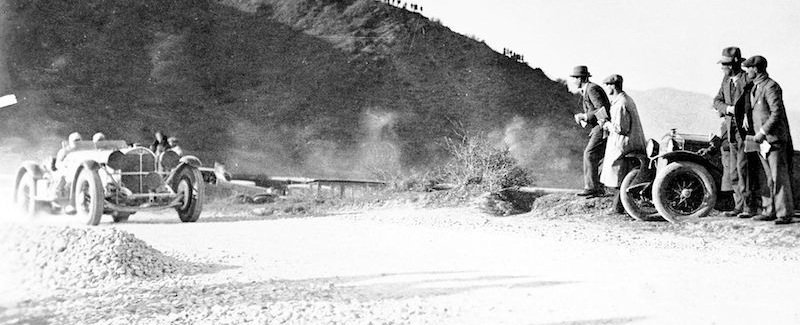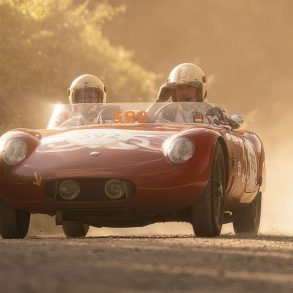In April 1931, Rudolf Caracciola became the first non-Italian to win the Mille Miglia road race. Alongside his co-driver Wilhelm Sebastian, the Mercedes-Benz works team driver won the 1,635km race, which took place from 12 to 13 April 1931, in a Mercedes-Benz SSKL racing car.
Caracciola achieved an average speed of 101.1 km/h in the race from Brescia to Rome and back. It was the first time that the Mille Miglia – traditionally dominated by Italian drivers – had been won by a foreigner in a foreign car and the first time that a driver’s average speed exceeded 100 km/h.The Mercedes-Benz driver received a gold medal from the King of Italy and a cup from the Automobile Club of Germany in recognition of his victory.
Three years later, Caracciola described that Mille Miglia in his first autobiography Rennen – Sieg – Rekorde (Races – Victory – Records), in which it was clear the race had a left a deep and lasting impression on him: “1,600km on dusty country roads, passing gorges and ravines … around horrible corkscrew bends and snake-like passages; through cities, towns and villages and again along dead-straight roads at an average of 150, 160, 170km … one night and then another day.”
Italian drivers seemed to hold the advantage: they knew the route and, since some makes had almost 50 cars on the starting grid, they had countless depots and mechanics positioned along the course. Mercedes-Benz was unable to offer such resources at that time, and Caracciola in fact had to enter as a private team that simply received support from the company. Due to the impact of the international economic crisis, Mercedes-Benz’s official team was unable to join the line-up in Italy in 1931.
But Caracciola rose to the challenge: “I sat behind the wheel for 16 hours, we thundered across the length and breadth of Italy for 16 hours, following the beam of our headlights through the night, driving into the blinding glare of the spring day.”
The race was full of uncertainties: where was Mercedes-Benz in the field of more than 100 drivers? Even on the final leg, Caracciola did not know that Tazio Nuvolari had dropped out or that he had overtaken Giuseppe Campari.
At the finish line, he was welcomed by the jubilant Mercedes-Benz racing team manager Alfred Neubauer with news of his win: “Neubauer was beside himself, leaping about and dancing for joy. What was going on …? I didn’t understand … not yet … but then it dawned on me: I had won the Thousand Miles – the first and so far [1934] only time that a foreigner has won in a foreign car.”
The torture was worth it, he had topped the overall standings. Fans and experts alike were overwhelmed by the German driver’s victory over his experienced Italian rivals. But Rudolf Caracciola did have some experience of the route by 1931. After all, the year before he had secured a category victory in the Mille Miglia (achieving sixth place in the overall standings) with Christian Werner as his co-driver, when he had driven a Mercedes SSK model.
The Mercedes-Benz SSKL model (Super-Sport-Kurz-Leicht or super-sport-short-light) that Caracciola drove in 1931 was the last version to be developed of the six-cylinder compressor sports car from Mercedes-Benz. The SSKL was only built as a two-seater racing car. Its in-line six-cylinder engine with a 7-litre cubic capacity produced 240 bhp (177kw) without and 300 bhp (221kw) with the compressor. The car’s maximum speed was up to 235 km/h. But the SSKL was not just strong in Italy, and Caracciola drove it to victory in the Eifel Race, the German Grand Prix and the Avus Race in 1931. He also took five wins in five races to defend his title in the sports car category of the European Hill Climb Championship.
The race: the ‘Thousand Miles’ of Italy
Mille Miglia – the 1,000-mile race through Italy – was one of the major competitions in European motor sports in the middle of the 20th century. This long-distance race was held between 1927 and 1957. But the history of the Mille Miglia, which started and finished in Brescia, began even earlier – and is still continuing today. The first car race on the Brescia–Cremona–Mantua–Brescia course took place on 11 September 1899 – regarded as the forerunner of the Mille Miglia.
However, the actual Mille Miglia was launched in 1927 when a group of automobile enthusiasts from the Brescia area planned to organise a long-distance race to Rome and back, covering a total distance of 1,000 miles. At the first race on 26 March 1927, 77 drivers competed – all of them from Italy. It was won by Ferdinando Minoia, followed by two victories by Giuseppe Campari and a win by Tazio Nuvolari in 1930. Campari and Nuvolari would be major rivals of Caracciola in 1931.
The new race quickly attracted a great deal of attention in Europe, where motor racing was extremely popular. As a result, Mercedes-Benz took part with its powerful compressor cars from 1930 onwards. Between 12 and 13 April 1930, Rudolf Caracciola at the wheel of a Mercedes-Benz SSK took sixth place in the overall standings and won his category. The average speed was 92.8 km/h. His epoch-making victory came the next year in 1931.
After the Second World War – and a break from motor racing for Mercedes-Benz that had begun in 1939 – Rudolf Caracciola took part in the Mille Miglia for a final time, driving a Mercedes-Benz 300 SL and crossing the finish line in fourth place. The duo of Karl Kling and Hans Klenk took second place – an impressive success in the competitive debut of the new 300 SL racing car (W 194).
“I was overjoyed to drive a 1,000-mile race without any trace of tiredness, despite the twelve-year break…It made it clear what progress had been made in car manufacturing.”
Caracciola was delighted with the technological advances made between the SSKL from 1931 and the 300 SL from 1952: “I was overjoyed to drive a 1,000-mile race without any trace of tiredness, despite the twelve-year break. The car was so easy to drive. The steering was gentle and precise. It was great to race in such a luxurious sports car … Dear me, what a difference to the thumping, dancing steering wheel of my 2,000kg Mercedes sports car with which I had won the Mille Miglia in 1931 on stony, dusty roads. It made it clear what progress had been made in car manufacturing.”
However, Caracciola was not the one to secure Mille Miglia glory for Mercedes-Benz in this era; instead, it was British driver Stirling Moss, three years later: In May 1955, Moss and his co-driver Denis Jenkinson won the Italian marathon race in a Mercedes-Benz 300 SLR, achieving an average speed record of 157.65 km/h, which still holds today. In second place was Moss’s team mate Juan Manuel Fangio, who crossed the finish line about half an hour later and also in a Mercedes-Benz 300 SLR.
Serious accidents resulted in the Mille Miglia being dropped as a road race after the 1957 season. The modern eponymous event has taken place in the form of a regularity rally for vintage cars since 1977. Cars that enter must be of a model type that took part in the race up to 1957.
1931 Mille Miglia – Photo Gallery






[Source: Mercedes-Benz]











Great! Things I didn’t know!
I’d always thought that the “K” in “SSKL” stood for Kompressor, as Mercedes uses it today.
I’ve never seen Neubauer so thin.
Caracciola’s insight on the difference between 1931 and 1952 is priceless.
Thanks.
I found this photo of Neubauer “as a young man.”
http://www.radio.cz/de/rubrik/geschichte/motorsport-legende-alfred-neubauer-und-seine-wurzeln-in-maehren/pictures/c/osobnosti/neubauer_alfred/neubauer_mladi.jpg#pic
Great picture,s and stories on SSK-SSKL,reading your Digest reminds me of when I used to collect Sports Car Graphic and Sports Car ILLustrated,I cut out the good parts from Road and Track also (miss Phil Hill) Good Luck in the future! BERTLION